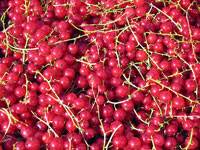 Red currants, the beautiful ruby red berries pictured above, make the perfect tart jelly. Growing in grape-like clusters on small bushes, the fruit has become a rarity in the United States. Mistakenly thought to promote a tree disease, currant bushes across the country were systematically uprooted in the early 1900s, and production was prohibited for many years.
Red currants, the beautiful ruby red berries pictured above, make the perfect tart jelly. Growing in grape-like clusters on small bushes, the fruit has become a rarity in the United States. Mistakenly thought to promote a tree disease, currant bushes across the country were systematically uprooted in the early 1900s, and production was prohibited for many years.
Currants are high in vitamin C and taste tart but pleasant when eaten. Commonly red and black currants are made into jellies. In fact black currant jelly or jam is very popular in England. I remember that while studying abroad in London, no matter how hard I looked, I could not find Concord grape jelly for my peanut butter sandwiches, so black currant jelly became my unusual but greatly liked substitute. Red currant jelly is practically the same color as black currant jelly, so after making this you really won’t tell the difference.
Every year we pick every last red currant berry off the small bushes in my parents’ yard and make jelly. It has been a summer tradition since I can remember. I really appreciate that we have the berries available at our fingertips.
The Amateur Gourmet has a good recipe for red currant jam that leaves in the seeds. But here is any easy—but it can be a bit messy—recipe for seedless red currant jelly. Use the delightfully tart jelly for filling pastries or simply spread it on toast.
Seedless Red Currant Jelly
3 pints red currants (about 6 cups berries without stems)
2 cups granulated sugar
Combine the currants and the sugar in a large pot and set over medium-high heat. The berries should release their liquids and begin to bubble and foam. Stirring occasionally, simmer slowly, and allow it to reduce in volume by half. Let the mixture cool.
Into a medium-size pot strain and press the berry mixture through a fine sieve or chinois. Put the pot back onto medium-high heat and reduce by half again. Let the mixture cool.
Fill a sterilized canning jar with the cooled berry mixture. A quart-size Mason jar should do. Leave a 1/4-inch space between the jelly and the top of the lid; tighten on a self-sealing lid. Process the jar for about 5 minutes in a boiling water canner. The jelly can be stored in the pantry for up to a year.

